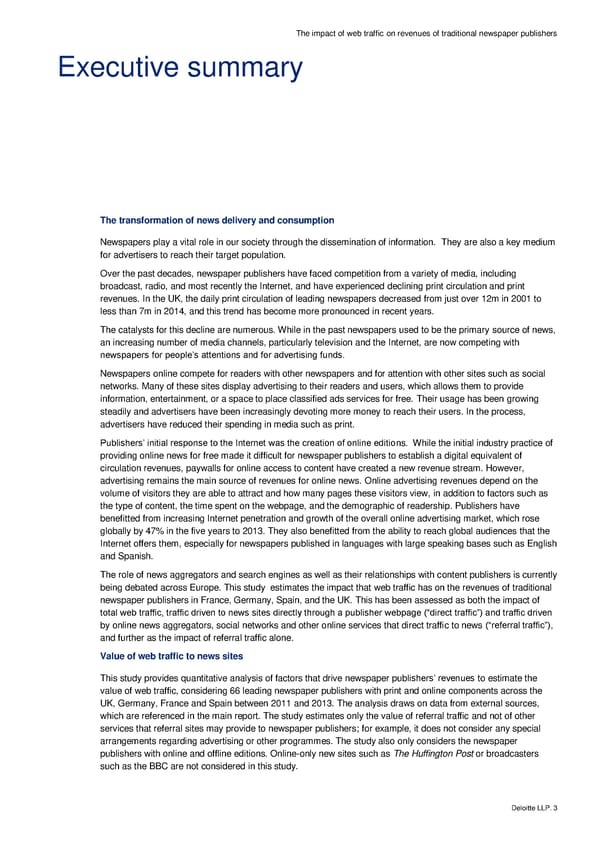The impact of web traffic on revenues of traditional newspaper publishers Executive summary The transformation of news delivery and consumption Newspapers play a vital role in our society through the dissemination of information. They are also a key medium for advertisers to reach their target population. Over the past decades, newspaper publishers have faced competition from a variety of media, including broadcast, radio, and most recently the Internet, and have experienced declining print circulation and print revenues. In the UK, the daily print circulation of leading newspapers decreased from just over 12m in 2001 to less than 7m in 2014, and this trend has become more pronounced in recent years. The catalysts for this decline are numerous. While in the past newspapers used to be the primary source of news, an increasing number of media channels, particularly television and the Internet, are now competing with newspapers for people’s attentions and for advertising funds. Newspapers online compete for readers with other newspapers and for attention with other sites such as social networks. Many of these sites display advertising to their readers and users, which allows them to provide information, entertainment, or a space to place classified ads services for free. Their usage has been growing steadily and advertisers have been increasingly devoting more money to reach their users. In the process, advertisers have reduced their spending in media such as print. Publishers’ initial response to the Internet was the creation of online editions. While the initial industry practice of providing online news for free made it difficult for newspaper publishers to establish a digital equivalent of circulation revenues, paywalls for online access to content have created a new revenue stream. However, advertising remains the main source of revenues for online news. Online advertising revenues depend on the volume of visitors they are able to attract and how many pages these visitors view, in addition to factors such as the type of content, the time spent on the webpage, and the demographic of readership. Publishers have benefitted from increasing Internet penetration and growth of the overall online advertising market, which rose globally by 47% in the five years to 2013. They also benefitted from the ability to reach global audiences that the Internet offers them, especially for newspapers published in languages with large speaking bases such as English and Spanish. The role of news aggregators and search engines as well as their relationships with content publishers is currently being debated across Europe. This study estimates the impact that web traffic has on the revenues of traditional newspaper publishers in France, Germany, Spain, and the UK. This has been assessed as both the impact of total web traffic, traffic driven to news sites directly through a publisher webpage (“direct traffic”) and traffic driven by online news aggregators, social networks and other online services that direct traffic to news (“referral traffic”), and further as the impact of referral traffic alone. Value of web traffic to news sites This study provides quantitative analysis of factors that drive newspaper publishers’ revenues to estimate the value of web traffic, considering 66 leading newspaper publishers with print and online components across the UK, Germany, France and Spain between 2011 and 2013. The analysis draws on data from external sources, which are referenced in the main report. The study estimates only the value of referral traffic and not of other services that referral sites may provide to newspaper publishers; for example, it does not consider any special arrangements regarding advertising or other programmes. The study also only considers the newspaper publishers with online and offline editions. Online-only new sites such as The Huffington Post or broadcasters such as the BBC are not considered in this study. Deloitte LLP. 3
 The impact of web traffic on revenues of traditional newspaper publishers Page 6 Page 8
The impact of web traffic on revenues of traditional newspaper publishers Page 6 Page 8